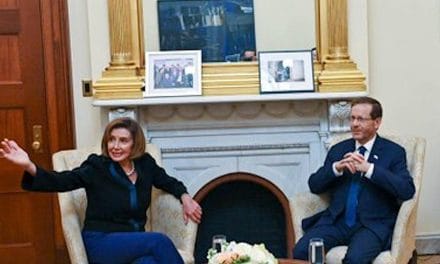A baby Jesus displayed on a keffiyeh, a decoration, was given by the Palestinian Higher Committee of Churches Affairs, and used as the “Nativity of Bethlehem 2024” during its inauguration in the Paul VI Hall, during a private audience to donors of the nativity scene and the lighting of the Christmas tree ceremony at St. Peters Square in the Paul-VI hall at the Vatican on Dec. 7, 2024. Photo courtesy of Andreas Solaro/AFP via Getty Images.
JNS
Following a flurry of controversy, the Vatican chose to remove a nativity decoration that included a baby Jesus atop a black-and-white keffiyeh, a symbol often linked to Palestinian nationalism.
Artists Johny Andonia and Faten Nastas Mitwasi, Palestinians from Dar al-Kalima University in Bethlehem, had designed the display in Rome.
On Sunday, Dec. 8, the Palestinian Mission to the United Nations wrote on X that “the Higher Presidential Committee for Church Affairs in Palestine on behalf of the State of Palestine gifted the nativity scene made in Bethlehem to the Vatican and in the presence of the pope who prayed for peace.”
The backlash came almost immediately from religious entities and individuals worldwide.
On Monday, B’nai B’rith International described feeling “disturbed by the Vatican display of a Palestinian-made nativity scene featuring Jesus on a keffiyeh and the pope’s appearance with it.” The group said the display “isn’t just politicization, but revisionism. It presents (only) Palestinians as innocent victims—and Jesus as a Palestinian, not a Jew.”
Non-Jewish groups also had their say, protesting the politicization of a Christian religious symbol.
In response to the display’s removal, David Parsons, senior vice president and spokesman for the International Christian Embassy Jerusalem, noted that “we are relieved at reports that the Vatican has decided to remove the provocative nativity display with an infant Jesus resting on a black-and-white keffiyeh, which is an unmistakable symbol of Palestinian nationalism.”
He said “this crèche not only denigrated Jewish heritage, it also undermined core tenets of the Christian faith. Indeed, millions of Christians worldwide were instantly incensed by this exhibit ahead of the Christmas season. The Vatican did the right thing in taking it down.”
Parsons described the display as “theological malpractice for the Holy See to allow this display to remain. For if Jesus was a Palestinian Arab, then he would not have qualified to be Christ, the promised messiah and savior of the world.”








